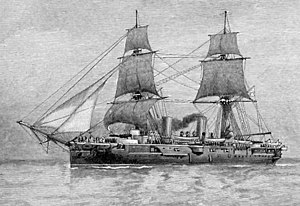HMS Warspite (1884)
 HMS Warspite, about 1885, with her original 2 brig masts
| |
| History | |
|---|---|
| Name | HMS Warspite |
| Builder | Chatham Dockyard |
| Laid down | 25 October 1881 |
| Launched | 29 January 1884 |
| Commissioned | 1886 |
| Fate | Sold for breaking up 4 April 1905 |
| General characteristics | |
| Class and type | Imperieuse-class armoured cruiser |
| Displacement | 8,400 t (8,300 long tons) |
| Length | 315 ft (96 m) pp |
| Beam | 62 ft (19 m) |
| Draught | 26 ft 9 in (8.15 m) |
| Propulsion | 2 Shaft Penn engine |
| Speed | 16.75 knots (31.02 km/h) |
| Complement | 555 |
| Armament |
|
| Armour | Belt: 10 in (250 mm) |
HMS Warspite was an Imperieuse-class first-class armoured cruiser, launched on 29 January 1884 and commissioned in 1886.
Construction[]
Morris[1] states that Warspite had her sailing rig removed while building. The illustration of her with masts therefore shows her on trials, or is conjectural.
Service history[]
Warspite was the flagship on the Pacific Station between 1890 and 1893, then a port guard ship at Queenstown until 1896. From 1896 until 1902 she again served as the flagship of the Pacific Station. Captain was appointed in command in March 1899, when Rear-Admiral Henry Palliser was Commander-in-Chief of the station. In June 1899 she became the flagship of Rear-Admiral Lewis Beaumont, who kept Captain Walker as flag captain. The ship visited Coquimbo in March 1900.[2] From late 1900 she was the flagship of Rear-Admiral Andrew Bickford, with Captain Colin Richard Keppel as flag captain in command of the ship.[3] In late March 1902, Rear-Admiral Bickford transferred his flag to the newly arrived HMS Grafton, and was joined by Captain Keppel. Warspite returned home under the command of Captain (who had arrived on Grafton),[4] stopping at Bahia and São Vicente, Cape Verde on the way. She arrived at Plymouth on 28 May 1902,[5] and paid off at Chatham on 1 July,[6] when she was placed in the D Division of the Dockyard reserve and prepared for emergency service.[7]

She was sold on 4 April 1904 to Thos. W. Ward of Preston. She arrived on the River Mersey on 3 October 1905 and then travelled on to Preston for breaking up.
Notes[]
- ^ Morris, Douglas Cruisers of the Royal and Commonwealth Navies 0907771351 p. 30
- ^ "Naval & Military Intelligence". The Times (36090). London. 15 March 1900. p. 7. template uses deprecated parameter(s) (help)
- ^ "Naval & Military intelligence". The Times (36395). London. 6 March 1901. p. 10. template uses deprecated parameter(s) (help)
- ^ "Naval & Military intelligence". The Times (36720). London. 20 March 1902. p. 10. template uses deprecated parameter(s) (help)
- ^ "Naval & Military intelligence". The Times (36780). London. 29 May 1902. p. 7. template uses deprecated parameter(s) (help)
- ^ "Naval & Military intelligence". The Times (36809). London. 2 July 1902. p. 7. template uses deprecated parameter(s) (help)
- ^ "Naval & Military intelligence". The Times (36794). London. 14 June 1902. p. 9. template uses deprecated parameter(s) (help)
References[]
- Chesneau, Roger & Kolesnik, Eugene M., eds. (1979). Conway's All the World's Fighting Ships 1860–1905. Greenwich, UK: Conway Maritime Press. ISBN 0-8317-0302-4.
- Friedman, Norman (2012). British Cruisers of the Victorian Era. Barnsley, South Yorkshire, UK: Seaforth. ISBN 978-1-59114-068-9.
- Lyon, David; Winfield, Rif (2004). The Sail & Steam Navy List. London: Chatham Publishing. ISBN 1-86176-032-9.
- Parkes, Oscar (1990). British Battleships (reprint of the 1957 ed.). Annapolis, Maryland: Naval Institute Press. ISBN 1-55750-075-4.
- Silverstone, Paul H. (1984). Directory of the World's Capital Ships. New York: Hippocrene Books. ISBN 0-88254-979-0.
External links[]
| Wikimedia Commons has media related to HMS Warspite (ship, 1886). |
- Imperieuse-class cruisers
- Ships built in Chatham
- 1884 ships
- Victorian-era cruisers of the United Kingdom
- United Kingdom naval ship stubs